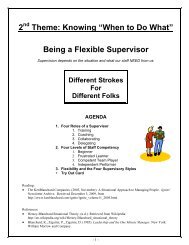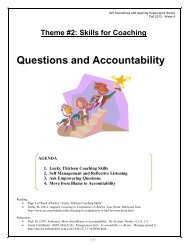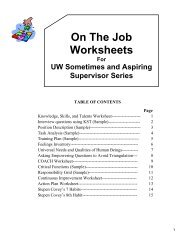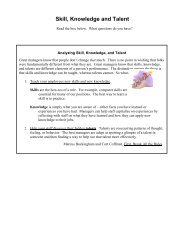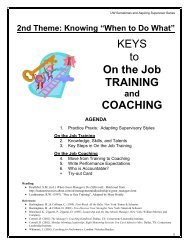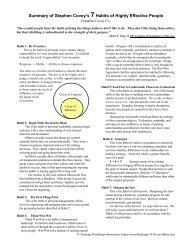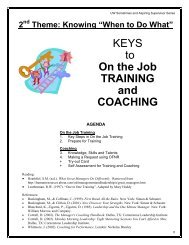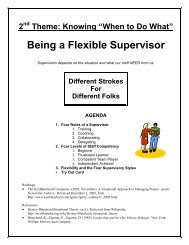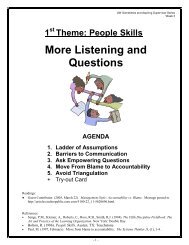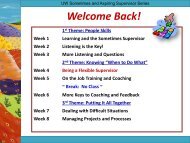Handouts
Handouts
Handouts
Create successful ePaper yourself
Turn your PDF publications into a flip-book with our unique Google optimized e-Paper software.
III. VOCAL:PACEThe speed at which your thoughts are put together out loud. Normal conversational speech is done with rapidbursts of sound. Public speaking pace should be slower and more deliberate than conversational speech. Whatmay seem to be too slow to the speaker is very likely just right for the audience. The pace you choose may berelated to the kind of audience and content of your material. Aim for a slow pace, with lots of pauses betweenideas.Speed kills, especially when a talk is loaded with statistics, technical phrases, complex ideas. (Reading statisticsis safer than saying them from memory. You will sound more trustworthy.)RHYTHMWhen writers work to shape their prose, they have a weighty tool at their command: rhythm.Except for the word "rhythm," the entire previous sentence is written in iambic meter. An iamb is two syllables,the first unstressed, the second stressed. "Express" is an iamb. So is "rehearse." On the other hand, the word"rhythm" is a trochee, a stressed syllable followed by an unstressed syllable.How does this mini-lesson in meter relate to presentations? Because good writers, and good presenters, knowthat rhythm is most powerful when it changes.Shakespeare's plays, for example, are written predominantly in poetic lines of five iambs each (iambicpentameter), but it is rare that more than three or four lines at a time are in absolutely perfect iambic. Why?Because without variation the meter starts to dull the ear like the constant clakety-clakety of a train. (Singsong)As the speaker, you have a wide array of ways to use rhythm to give your listeners variety. One of the mostobvious is speeding up and slowing down. You can think of doing this with a long arcing vision—beginningan entire presentation at a moderate pace and then building and building the pace as you get farther along. Or itcan be done with a micro-view—altering your speed within individual sentences.A fun way to play with rhythm that many people use is to get to the end of a sentence and simply say one . . .word . . . at . . . a . . . time. If you need to communicate passion or importance, this is a simple and effectivetechnique.You might also examine whether all your ideas are expressed with sentences that are the same length. If yourlisteners can begin to predict how your ideas will be shaped, they'll stop listening.Many people fear they speak too quickly. This is rarely the case. Our ears can process more words per minutethan our mouths can articulate. But what is often missing is the full stop at the end of one thought before thenext thought begins. Using a pause is a powerful way to alter your rhythm and get people to tune in.(Do you remember your grade school teacher stopping speaking mid-sentence? Every head came up and alleyes went to her. Pauses have power!)5



